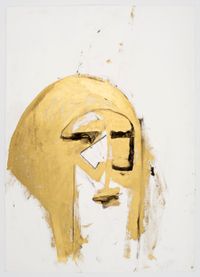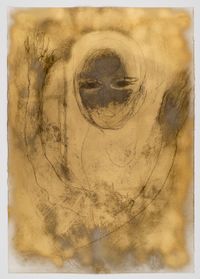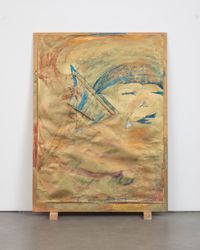


Webs of delicate copper wire coalesce into geometric forms, faces materialise through smokycharcoal shadows, and eyes peer out from beneath Byzantine veils of gold. Strong or delicate, finished or unfinished, ancient or contemporary, the art of Marisa Merz is intensely dialogical. Viewing her works entails entering into a conversation with them. Meanings, and our understandings, deepen through a process of engagement with the seemingly opposed forces, states, or materials she harnesses in each work. We explore the edges of a gestural drawing to discover traces of a compositional scaffolding, we interrogate a block of wax to understand if it is liquid or solid, and we seek a figure emerging from a lump of unfired clay.The persistently enigmatic qualities of her works have frequently been understood as a feminist strategy, a way to side-step an aesthetic language that was inaccessible to, or atleast ill-fitting for, women in mid-century Italy.1 Others have argued that such a lens limits ourability to understand her contributions to the broader history of sculpture, of postwar figuration, and of conceptual art.2 Understanding her works as invitations to dialogue–to investigate materials, sensations, and imagery–allows us to see the way Merz questioned the traditional role of the artist in ways that aligned with the most radical perspectives of her(male) Arte Povera colleagues, and, simultaneously, recast artistic identity in her own (female)image.
Merz's artistic debut was distinctly different from the rest of the Arte Povera cohort in that it did not come in an essay or exhibition organised by curator Germano Celant or hosted by Gian Enzo Sperone's gallery, rather it can be traced to when she invited friends to see the pendulous sewn-aluminium forms known as Living Sculpture (1966) that had been steadily taking over the Turin home/studio she shared with her husband, artist Mario Merz, and their young daughter. That she understood raising a child and being an artist part of the same lived experience is evidenced in several works, such as the swing she built in their apartment and exhibited as a sculpture, or the 'interview' she gave art critic Mirella Bandini, the entirety of which comprised a transcript of Merz and her daughter Bea discussing what to eat for lunch(not cake, but potatoes and homemade mayonnaise).3 Merz's artworks graced Italian art galleries soon enough, as well as Turin's experimental Piper Pluri Club, and she was invited to crucial international exhibitions of the era, where she contributed conceptual works and delicately balanced installations of organic and inorganic materials: knit copper and nylon threads, wax casts, or vessels filled with salt. In the early 1980s she began to make and exhibit the figurative drawings and small ceramic sculptures that would occupy so much of the subsequent four decades.
This simple chronology belies a more complex story, one in which Merz challenged the boundaries of how historians assess a career, how galleries market a body of work, and how viewers approach an artwork. As Merz was reticent to date or even title most of her works, each remained theoretically open to the possibility of being changed, renewed, or subsumed into another project throughout her life. Several works embody this in their very structures. Aknit piece might be unraveled and reformed like any other skein.4 A rolled-up blanket displayed in one installation might be unfurled in another. In the current exhibition, a small, untitled, clay-and-pastel head sits on a low pedestal of wax, a material that is effortlessly transmuted from solid to liquid with a modest introduction of heat. Might the unfired clay justas easily return to dust and be reformed? This realisation evokes reflection on other organic life cycles such as our own. In this Merz's works typify one of the most salient features of theart produced by her Torinese colleagues (Giovanni Anselmo, Piero Gilardi, Mario Merz, Giuseppe Penone, Michelangelo Pistoletto, GIlberto Zorio) in the late 1960s: the work of art serves as a catalyst for a greater understanding of the nature of being through corporeal, multi-sensory experience.
Beyond this, her mostly untitled drawings refuse the kind of particularity that would pin down and ultimately limit our readings of them. When fortunate enough to see them in groups, we see resonances among them, hints of recurrent figures but without any identifying subjectivity.Does it really matter if the artist considered the image as a self-portrait, an angel, or a marian figure? Can the answer be 'all of the above'? From a feminist perspective, the refusal of specificity bears witness to the intersectionality of female experience as overlapping, multiple, diachronic identities clash and meld. Identity cannot be fixed any more than the artwork can result in a single message. Rather, the encounter with the image and its constituent materials in the present time of the viewer is what gives rise to meaning.
In this refusal to fix her works with words or dates, Merz rejected the measures of artisticproduction that would otherwise seek to quantify, in industrial-capitalist terms, both her ownlabor and the experience of the viewer.5 We might read this as connected to the way women'sfamilial labor is often unpaid and invisible, but deeply felt. At the same time, we can connect itto the theoretical framework introduced by Umberto Eco, whose 1962 publication Operaaperta or 'open work' dispensed with the Crocean notion of art as a mental phenomenon infavour of a more aleatory, collaborative, and phenomenological definition of exchange between the artist and the viewer through the object or text.6 Rather than seeking information orknowledge from the work, delivered in a monologic address from artist to viewer, the viewer istasked with searching the work for traces of meaning, learning from the process for which theobject is a prompt or proposition.
Look, for example, at Merz's gold-covered clay sculpture (Untitled, undated): barely larger thana closed fist, it bears three carved mandorla, or almond-shaped depressions, through whichtwo eyes and a mouth may be read. A figure starts to emerge from the depths of the solidform, and the viewer begins to feel protective of this diminutive object, this coming-into-being.Or is it slipping away from our world? The gilding might recall the material treatments in Italianart, from the Quattrocento through the Baroque, that were reserved for the backgrounds,garments, and aureola of holy figures, while the unfired clay beneath it testifies to a terrestrialcore. Together these materials reinforce the sense that this fragile figure is between heavenand earth, between formlessness and solidity, between the ephemeral and the everlasting. Isthis an ancient artifact, a recently unearthed ritual object, or a rebuttal to the modern cult ofthe individual, the easily identifiable, or the commodified body interpolated by data-driventechnologies?
The figure's oscillation autonomous and fragmentary in Merz's drawings and sculpturesindicates the lived body's imbrication with its environment. A large, untitled work on paperenacts this searching in-betweenness in its image and structure. A face materialises on theupper right, sketched in cerulean blue on a shimmering gold surface that suggests the sun inthe sky as much as a figure on a ground. Is the sun an object like a body? If so, should weconsider its light matter, rather than energy? To such existential questions the drawingresponds by exceeding the paper's border on the upper left, extending onto the support(response: this is both an image and an object). Strands of copper wire collaged on top of thepaper radiate out from the lower left, as if to reign in the drawn figure, or, alternatively, totransmit its energy through the conductive elemental wire. By staying with such works, andinvestigating the materials and imagery that reoccur in Merz's practice, we can begin tounderstand the power of her dialogical approach. Beyond the strictures imposed by language,chronological history, and artistic disciplines, the openness of Marisa Merz's works force us tostay in the moment, in the conversation. They ask us to be present in the experience of anobject, our bodies, a space, the world.
1 Feminist readings of her works begin with her earliest champions, such as Tommaso Trini, who wrote of the distinctive radicality of her Living Sculpture in 1967. See Tommaso Trini, "Marisa Merz," Domus 454 (1967), 52. More thorough and contemporary readings of her work in this vein include essays by Connie Butler and Lucia Re in Connie Butler, ed. Marisa Merz: The Sky is a Great Space (Los Angeles, Hammer Museum, 2017).
2 Teresa Kittler convincingly argues for seeing Merz's work both through and beyond a feminist lens, ascontemporaneous alternatives to the entropic interests of American artists like Robert Smithson. Teresa Kittler, "Outgrowing the Kitchen: Marisa Merz's Living Sculpture," in Butler, ed. Marisa Merz, 229-245.
3 Mirella Bandini (a cura di), "Torino 1960-1973," NAC, n.3 (March, 1973). Reprinted in Mirella Bandini, 1972: Arte povera a Torino (Turin: Allemandi, 2002), 57.
4 Lucia Re has connected the knitting needles themselves to a specifically feminist way of working that could be considered dialogical. Based on the semiotics of Luisa Muraro, Re argues that the two needles work together and in opposition, as metaphoric and metonymic structures create different kinds of meaning in language. See Lucia Re, "The Mark on the Wall: Marisa Merz and a History of Women in Postwar Italy," in Butler, ed. Marisa Merz, 47.
5 Carolyn Christov-Bakargiev discusses the way repetition in Merz's work marks a 'liberation from chronological time,' which is important to understanding their power. See Carolyn Christov-Bakargiev, "You Can Make Shoes Out of Brains," in Butler, ed. Marisa Merz, 274.
6 Umberto Eco, The Open Work, trans. Anna Cancogni (Cambridge: Harvard University Press, 1989). Originally published in Italian as Opera aperta (Milan: Bompiani, 1962). Eco and his theories were referenced in Celant's ersatz-manifesto for Arte Povera published in Flash Art in November/December 1967: 'Arte povera: appunti per una guerriglia.'
Press release courtesy Gladstone Gallery. Text: Elizabeth Mangini.
130 East 64th Street
New York
United States
gladstonegallery.com
+1 212 753 2200
Tuesday - Saturday
10am - 6pm